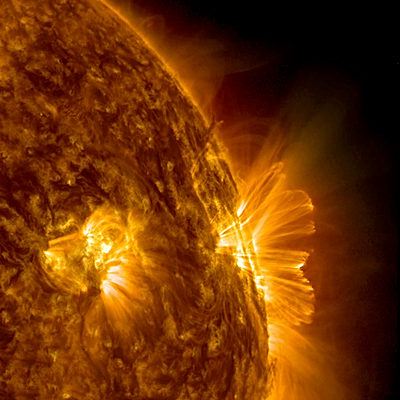478

Image: A plasma ejection during a solar flare. Immediately after the eruption, cascades of magnetic loops form over the eruption area as the magnetic fields attempt to reorganize. Source: Solar Dynamics Observatory, NASA
One of the major mysteries of solar physics is why the Sun’s corona, the outermost part of its atmosphere reaches temperatures of several million degrees Celsius. A “hot” path leading to a region of the solar atmosphere just below the corona, where sound waves and certain plasma waves move at the same speed, explains this effect.
A team from the Helmholtz-Zentrum Dresden-Rossendorf (HZDR), a German national lab, developed a laboratory model and for the first time experimentally confirmed the theoretically predicted behaviour of these plasma waves – called Alfvén waves. This was done in an experiment using the molten alkali metal rubidium and pulsed high magnetic fields, as reported in the journal Physical Review Letters.
In solar physics, it is now commonly believed that magnetic fields play a significant role in heating the Sun’s corona. However, whether this impact is primarily due to a rapid shift in magnetic field structures in the solar plasma or to the dampening of various types of waves is still debated. Our Sun’s core is unimaginably hot, at 15 million degrees Celsius. Its light is emitted at a relatively cool 6000 degrees Celsius on its surface.
Dr Frank Stefani says, “It is all the more astonishing that temperatures of several million degrees suddenly prevail again in the overlying Sun’s corona.” His team conducts research at the HZDR Institute of Fluid Dynamics on the physics of celestial bodies – including our central star. Stefani considers corona heating to be one of the great mysteries of solar physics, one that he keeps pondering in the form of a simple question: “Why is the pot warmer than the stove?”
“Just below the Sun’s corona lies the so-called magnetic canopy, a layer in which magnetic fields are aligned largely parallel to the solar surface. Here, sound and Alfvén waves have roughly the same speed and can therefore easily morph into each other. We wanted to get to exactly this magic point – where the shock-like transformation of the magnetic energy of the plasma into heat begins,” says Stefani.
The Alfvén waves were initially seen in liquid-metal tests shortly after their prediction in 1942 and after wards researched in detail in complex plasma physics facilities. Only the magnetic canopy conditions, which are critical for corona heating, have remained inaccessible to experimenters until now. On the one hand, the Alfvén speed in large plasma studies is often significantly faster than the speed of sound. On the other hand, it has been much lower in all liquid-metal tests to date. This is due to the low magnetic field intensity of conventional superconducting coils, which have a constant field of roughly 20 tesla (unit of measurement to define the magnetic flux density).
HDZR’s Dresden High Magnetic Field Laboratory found a solution around the low magnetic fields of superconducting coils in the form of pulsed magnetic fields which could even reach over 100 tesla, i.e. roughly 2 million times the earth’s magnetic field. Rubidium, an alkali metal with severe reactions to air and water, at 54 tesla is already capable of allowing Alfven waves to break through the sound barrier, according to the liquid characteristics of metals. The risks associated with handling rubidium made the team doubtful as to whether such a risky experiment was even needed. However, these doubts were quickly solved, dispelled and the experiment was carried forward.
Although not all observed impacts can be simply explained, the research adds a crucial piece to the mystery of the Sun’s corona heating. The researchers intend to conduct comprehensive numerical analysis and further experiments in the future. Other space missions are going to get additional insights into the Sun’s corona heating mechanism: the Parker Solar Probe and Solar Orbiter are about to obtain new insights at close range.

